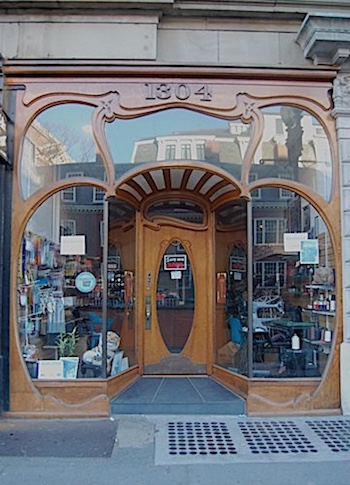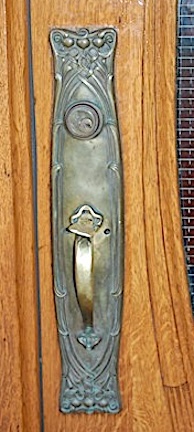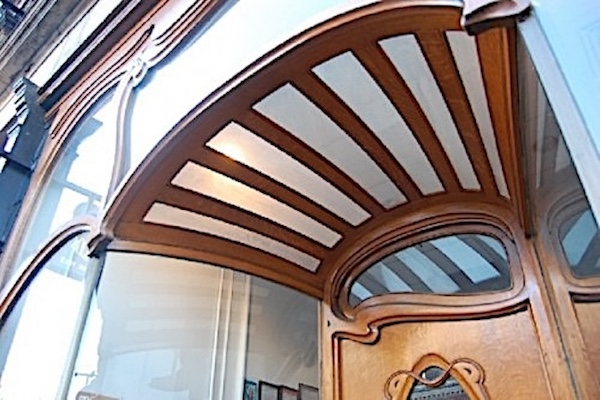Design Review: A Singular Art Nouveau Shopfront in Harvard Square
By Mark Favermann
Made 100 years before the current marketing phrase went abuzz, 1304 Massachusetts Avenue is an enticing example of a true immersive retail experience.

Art Nouveau façade of 1304 Massachusetts Avenue, Harvard Square. Photo: Mark Favermann
Located across the street from Harvard Yard at 1304 Massachusetts Avenue in Harvard Square in Cambridge, Massachusetts is one of the most distinctively Art Nouveau storefronts to be found anywhere in the United States. Its visually appealing character and personality are gloriously magnetic.
For sophisticated consumers in the post-Covid-19 world, online shopping has become a habit. In response, retailers and designers have increasingly taken to transforming retail environments; they are no longer mere product displays, but spaces that creatively tell stories, even offer experiences that might become powerful memories. The 1304 Massachusetts Avenue storefront was ahead of this beautifying game well over a century ago.
To be fair, Harvard Square in the City of Cambridge has fostered a charming commercial showplace via a wonderful array of colorful storefronts and quirky projecting signs. The scale and qualitative visual mixture of what’s been done is impressive. Still, the storefront, now in the hands of the Felix Shoe Repair, stands out.
Art Nouveau is characterized by its use of a long and sinuous organic line. Its visual “flow” was meant to correspond to musical movement. A self-conscious attempt to create a “modern” look — free of the imitative historicism that had dominated much of 19th-century art and design — the style was most often used in architecture, interior design, jewelry, glass objects, and illustration. The emphasis on refinement was a cultural reaction to the excesses of the industrial revolution’s twin accomplishments — technological triumphs and deplorable social conditions. In England, influential social critic and artist/designer William Morris was a vocal proponent of Art Nouveau. He and his followers viewed aesthetic and social problems as inseparable, insisting that artists should create work that was both beautiful and practical.
As a design motif, the style peaked around 1890, falling out of favor at the beginning of World War I in 1914. Countries interpreted Art Nouveau in divergent ways — the flowery French style became the most universally prevalent. Much later, the latter influenced what became Psychedelic Art in the ’60s and early ’70s. Though Art Nouveau buildings are now rare in the United States, numerous examples of buildings, houses, and apartments still stand in Paris, Brussels, Prague, Glasgow, Turin, and Riga.

Ornate front door handle at 1304 Massachusetts Avenue, Harvard Square. Photo: Mark Favermann
Harvard Square’s Art Nouveau storefront was designed by the Boston Brahmin architectural firm of Coolidge & Carlson for Coes & Young, a Boston shoe store firm. This exceptional shopfront was designed in 1907 but not completed until 1913. Admirably, its landlord, Harvard University Properties, has restored the façade to its original glory. The storefront reflects the brand of French Art Nouveau created by architect/designer Hector Guimard (1867-1942), the designer of the fabulous iconic Paris Metro subway entrances that are still in use today. Guimard was inspired by plant life — flower, vine, root, and leaf forms — convinced that they conveyed elegance and style.
“This store was occupied by my grandfather William and his cousin Felix Caragianes beginning in 1913,” recounts Jay Martel. “I became aware of the significance of its storefront at an early age. For years, it was covered by a large metal security gate which likely protected it from the elements. I took it down in 1970 before the store was forced to vacate by Harvard Properties and given over to Gnomon Copy at the end of June 1970. I was 21 at the time. Gnomon originally was going to replace the storefront with a steel and glass front, but there was a local uproar about it, and it was saved.”
I have admired this delightful façade for decades. I first saw it when it was being used as the front of a copy center, oddly named Gnomon Copy. The business’s philistine owner had hung a huge and ungainly illuminated sign on the façade, which interrupted the beautiful flowing wooden lines of the storefront’s elegant design. Composed of dangling heavy wires, a large metal case, and bad lettering, the visually “honking” ugly signage wasn’t taken down for decades. Seeing the device stuck on the delicate wooden façade visually pained me whenever I walked by. The Gnomon owner lived in my condo building, and I tried to speak to him about the marred façade from time to time. But he would accept no helpful suggestions. “Why shouldn’t I have a strong sign on my business?” he responded. No one was going to tell him what to do. Aesthetics and history be damned!
For years, not much changed. An unattractive sign brutalized a sensitively wrought, marvelously detailed shopfront. But then, miraculously, over the last two decades or so, a shoe repair service has occupied the store, and the façade has been sensitively brought back to its original glory. Art Nouveau was most often created in metal, but when the style was applied to housing, shops, or interior furniture, fine wood was usually used. This is the case with 1304 Massachusetts Avenue. The façade is fabricated out of hand-carved wood. Metal details, such as the kickplate at the bottom of the front door and door handle and ornamental lock plate, add an almost medieval quality to the beauty of the façade.

Entrance details of 1304 Massachusetts Avenue, Harvard Square. Photo: Mark Favermann
The store’s set back entranceway is stunning, its skylight canopy structure a highlight. The exquisitely detailed woodwork at the top inevitably draws the eye. The spacious open window treatments, with their vine-like forms, are shaped like colossal plants. Balanced asymmetrically in wood and glass, the door is a sculptural work of art. The result is a façade that offers a harmony rarely seen or felt in most of today’s contemporary shops. Over 100 years before the current marketing phrase went abuzz, 1304 Massachusetts Avenue is an enticing example of a true “immersive retail experience.”
Mark Favermann is an urban designer specializing in strategic placemaking, civic branding, streetscapes, and retail settings. An award-winning public artist, he creates functional public art as civic design. The designer of the iconic Coolidge Corner Theatre Marquee, he is design consultant to the Massachusetts Downtown Initiative Program and since 2002 has been a design consultant to the Boston Red Sox. Writing about urbanism, architecture, design and fine arts, Mark is contributing editor of the Arts Fuse.

At first I thought this was an example of New Traditional Architecture. What a breath of fresh air if it had been! Naturally, this beautiful piece still seems as fresh as when it was first installed.
It is rare to find such a great art nouveau work in America as it is usually a type of art to be found in Europe. I found this: The 11 most beautiful Art Nouveau cities in The Americas https://artnouveau.club/the-11-most-beautiful-art-nouveau-cities-in-america-ranking/
Xavi,
Thank you for great Art Nouveau references, especially in South America.
Mark
Thanks for renewing attention to this glorious shopfront. Always a joy to walk by since the Sixties when we had a renewed appreciation for Art Nouveau since lost.
Erica,
I always appreciate your personal perspective on art and the built environment.
Mark
A terrific read, Mark, about this now fully restored, iconic, celebrated storefront. I share your sympathies for its earlier abuse. Wonderful to see it all in its full glory.